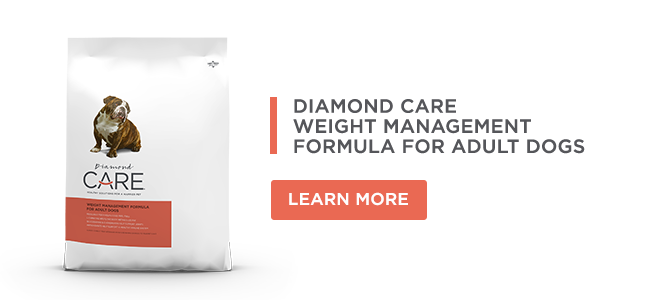Crash diets drastically reduce calories and promise people a quick method for losing weight. But the majority of humans eventually regain most or all of the weight lost on a gimmicky diet, meaning they have to do it again. Being trapped in the yo-yo cycle of dieting isn’t fun, and often, it’s not a safe way for people to lose weight. It isn’t a safe weight loss plan for dogs carrying excess weight, either.
The trouble with these fad diets for people or pets is that extreme calorie restriction alerts the body that it’s in starvation mode. In turn, the body pumps the brakes on metabolism, so it burns calories more slowly. Moderate calorie restriction and lifestyle changes (exercise and increased activity) for slow weight loss is a more sensible approach for overweight people — and overweight dogs, too.
Your veterinarian can help you tailor a healthy and safe weight loss program to your dog. Of course, it’s not just about counting calories; how much your dog exercises will also impact their weight loss rate.
How to Help My Dog Lose Weight
You might think dieting is simply a matter of feeding your dog less of the food they are currently eating. But manufacturers typically design dog foods to deliver a balance of nutrients within a certain caloric content. Simply cutting the quantity of food may not help your dog — it may put your dog at risk for nutritional deficiencies.
“Complete and balanced” is the phrase used by pet food companies to indicate that a dog food provides total nutrition for a specific life stage. A “complete” diet, according to the Association of American Feed Control Officials (AAFCO), is one that contains all of the nutrients currently known to be essential (except water) at levels adequate to meet a dog’s daily needs. In reality though, being complete isn’t good enough.
Dog food also has to be balanced to avoid nutrient deficiencies that can occur even though the diet appears to contain all the essential nutrients. A “balanced” food provides nutrients in the correct ratios so that optimal absorption of all nutrients occurs. And because most dogs eat or are fed to meet their energy (calorie) requirements, a food must also be balanced so that all nutrients in the proper amounts and ratios are consumed when dogs’ calorie needs are satisfied.
The best way to help your dog lose weight is to take them to your veterinarian first. Your vet will measure your dog’s weight and your dog’s body condition score to determine how much weight they should lose. They may recommend a therapeutic diet (weight loss dog food) that’s low in fat and high in fiber, such as Diamond CARE® Weight Management Formula for Adult Dogs. They can also determine the calories and amount of food your dog should be fed on a daily basis, based on factors like their breed, age and lifestyle. Don’t forget that dog treats have calories, too, and should be counted in the daily total.
How Fast Can Dogs Lose Weight?
In general, a safe rate of weight loss for dogs is 1 to 2 percent of their current body weight per week. For example, a 100-pound golden retriever can drop 1 to 2 pounds a week, or 4 to 8 pounds a month, on average.
Faster weight loss (more than 2 percent a week) puts your dog at risk of nutritional deficiencies and, after the diet is over, rebound weight gain.
While aiming for a loss of 2 percent of your dog’s weight per week is fine, keep in mind that your dog may play the hunger card, begging at the table and drooling every time you bring a potato chip to your mouth. If that happens, you can shift the weight loss goal to 1 percent or even 0.5 percent a week. It will just take a little longer to reach the final goal of a healthy dog weight.
How Long Does It Take for a Dog to Lose Weight?
Over time, weight loss will slow and even plateau. That’s why it’s important for you to schedule regular check-ins with your vet, even if it’s just to record your dog’s weight. They can adjust your dog’s weight loss plan as needed.
Let’s say your 100-pound dog now weighs 90 pounds, but the pounds just don’t drop off like they did before. A 90-pound dog requires fewer calories than their heavier counterpart, so your veterinarian can recalculate the calories needed and adjust the amount of your dog’s food that you should be feeding.
The Benefits of Gradual Weight Loss in Dogs
Recognizing the signs of dog obesity is important for your dog’s health. Dropping to a healthy weight can lower your dog’s risk for diseases such as diabetes, arthritis, heart disease, high blood pressure and certain types of cancer. And what could be better than more time with your best pal?








